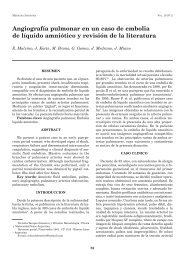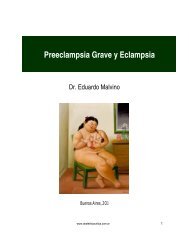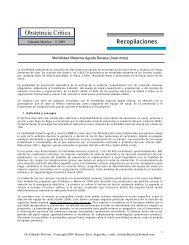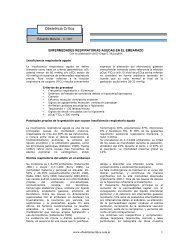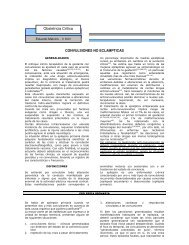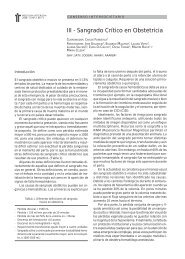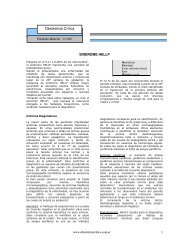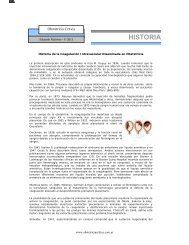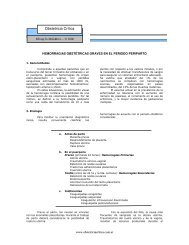Abstracts â 2008 - Obstetricia CrÃtica
Abstracts â 2008 - Obstetricia CrÃtica
Abstracts â 2008 - Obstetricia CrÃtica
You also want an ePaper? Increase the reach of your titles
YUMPU automatically turns print PDFs into web optimized ePapers that Google loves.
BACKGROUND: Thrombotic thrombocytopenic purpura is a rare disease.However, in pregnant women it occurs more frequently. Thromboticthrombocytopenic purpura may be a severe condition for both mother and fetus.CASE: This is a case of severe but temporary fetal heart rate abnormalities in apregnancy complicated by thrombotic thrombocytopenic purpura. There was aremarkably good outcome despite indications of an impaired fetal condition for aperiod of at least 48 hours. CONCLUSION: Based on the literature regardingtransient severe neurological symptoms in adults with thromboticthrombocytopenic purpura, we hypothesize that the transient fetal heart rateabnormalities were most likely due to reversible microthrombi in the placenta.Obstet Gynecol. <strong>2008</strong> Feb;111(2):505-7.Uterine artery embolization followed by dilation and curettage for cervicalpregnancy.Nakao Y, Yokoyama M, Iwasaka T.Department of Obstetrics and Gynecology Faculty of Medicine, Saga University,Saga City, Saga, Japan.BACKGROUND: Cervical pregnancy can be a life-threatening condition due tothe risk of severe hemorrhage. Progression of ultrasonographic diagnostictechnology has allowed the early detection of cervical pregnancy. However, astandard treatment protocol for fertility preservation has not yet been established.CASE: Two women with cervical pregnancy presented with cardiac activity at 6and 7 weeks of gestation. They were treated with transfemoral uterine arteryembolization followed by dilation and curettage with minimal bleeding. Onepatient gave birth to a healthy neonate 20 months after the procedure.CONCLUSION: Early cervical pregnancies were treated with dilation andcurettage after uterine artery embolization. This treatment can be considered asconservative management for patients who desire to preserve their fertility.Obstet Gynecol. <strong>2008</strong> Feb;111(2):502-4.Advanced abdominal pregnancy resulting from late uterine rupture.Naim NM, Ahmad S, Siraj HH, Ng P, Mahdy ZA, Razi ZR.Department of Obstetrics and Gynaecology, Faculty of Medicine, NationalUniversity of Malaysia, Hospital UKM, Kuala Lumpur, Malaysia.BACKGROUND: Advanced abdominal pregnancy is rare, and one that occursafter uterine rupture with delivery of a viable fetus is exceptional. CASE: Amultiparous patient was admitted at 29 weeks of gestation for conservativemanagement of placenta previa. She complained of intermittent abdominal pain,but repeated assessment suggested that both the patient and the fetus weredoing well. At 36 weeks, an abdominal pregnancy was diagnosed withradiological features suggestive of uterine rupture. Laparotomy was performedand a healthy infant was delivered. CONCLUSION: Fetal viability was achievedin this case of abdominal pregnancy secondary to uterine rupture after closematernal and fetal surveillance.Obstet Gynecol. <strong>2008</strong> Feb;111(2):487-489.



